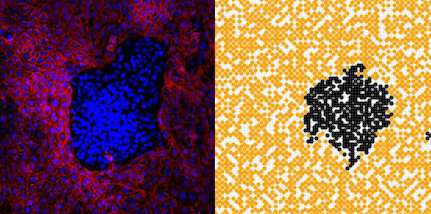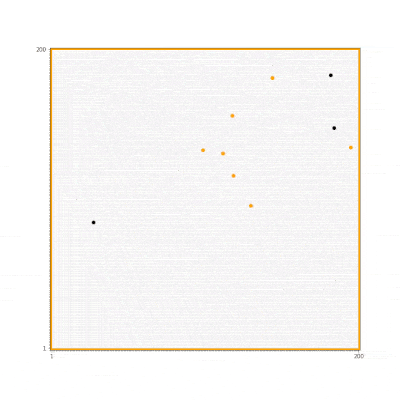Mathematical model mimics melanoma

Cancer cells' ability to tolerate crowded conditions may be one key to understanding tumor growth and formation, according to a mathematical model that has been applied to cancer cell growth for the first time. The model can replicate patterns of melanoma cell growth seen in laboratory experiments by controlling the 'exclusion area'—the amount of space required—around two types of simulated cells as they grow and spread. A paper describing the model and experiments appears in a recent issue of the journal Scientific Reports.
"When our collaborators grew melanoma cancer cells in a mixed culture with normal cells," said Yuri Suhov, professor of mathematics at Penn State and an author of the paper, "the cancer cells grew and spread more quickly, forming clusters of melanoma cells surrounded by non-cancer cells. This clustered pattern of melanoma cells resembled two-dimensional proto-tumors, so we were interested in modeling this pattern formation in order to understand what about the cancer cells allows them to grow in this way. Melanoma is a skin cancer of a relatively rare occurrence. However, it is one of most lethal forms of cancer characterized by a high potential for metastasis, which makes it crucial to understand the dynamics of the tumor growth and develop methods for early detection."
The researchers applied a modification of the Widom-Rowlinson model—a mathematical model that has been used in contexts ranging from theoretical chemistry to sociology—to try to determine what factors explained the pattern of cell growth seen in the laboratory experiments. Their model simulates the growth of two cell types that initially are evenly mixed and evenly spaced across a grid. By varying parameters of the model, the researchers can control the rate at which each cell type replicates, dies, and migrates, as well as the required exclusion area around the cells.

"By altering the exclusion distance between the two cell types in the simulations, we were able to replicate the clustered patterns seen in the experiments," said Izabella Stuhl, visiting assistant professor in mathematics at Penn State and another author of the paper. "The cell type with the narrower exclusion area was more tolerant of dense conditions and formed patterns almost identical to the clusters of melanoma cells seen in the laboratory experiments. This suggests that a reduction in 'contact inhibition'—a known factor that stops cells from replicating when they bump into other cells—may be what allows tumors to form."
In the course of their work, the researchers first made predictions based on the mathematical model. Then numerical simulations were conducted, in parallel with the co-culture experiments. The simulated results were repeatedly compared with the experimental data.
The researchers plan to continue to expand their model in combination with data from real-world experiments in cancer cell growth. This combination of theoretical modeling with laboratory experiments could lead to additional insights into the factors that contribute to cancer cell growth.
"Tumors grow in places where normal, healthy cells can't because the cells are already densely packed," said Suhov. "Contact inhibition, which we modeled as exclusion area, may be one of the things that prevents non-cancer cells from spreading uncontrollably, but cancer cells somehow overcome this. On the other hand, the normal cells try to form 'border layers', of a higher cell density, surrounding tumor-like clusters as if they wanted to isolate tumors and prevent them from spreading further. Our model shows that these factors are relevant when one tries to explain the images of cell growth seen in the laboratory. It is quite remarkable that the mixture of cells from unrelated biological sources shows a persistent pattern of behavior. However, we would like to expand this to gain a better understanding of how cancer cells behave within a natural setting. As we continue to refine our model based on additional experimental data, we may be able to build in parameters that allow us to better understand the precise biological processes that cause tumors to form."
Journal information: Scientific Reports
Provided by Pennsylvania State University


















